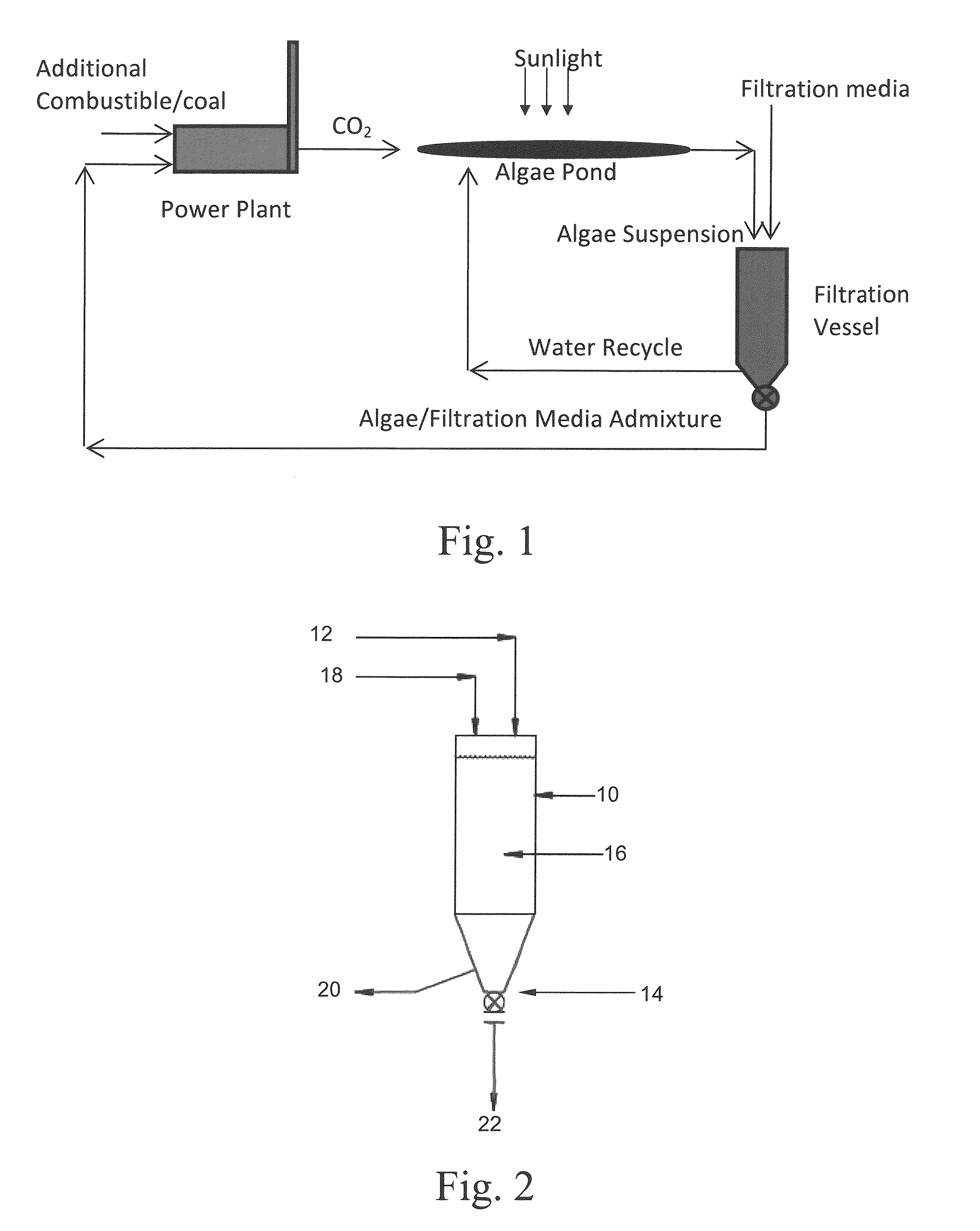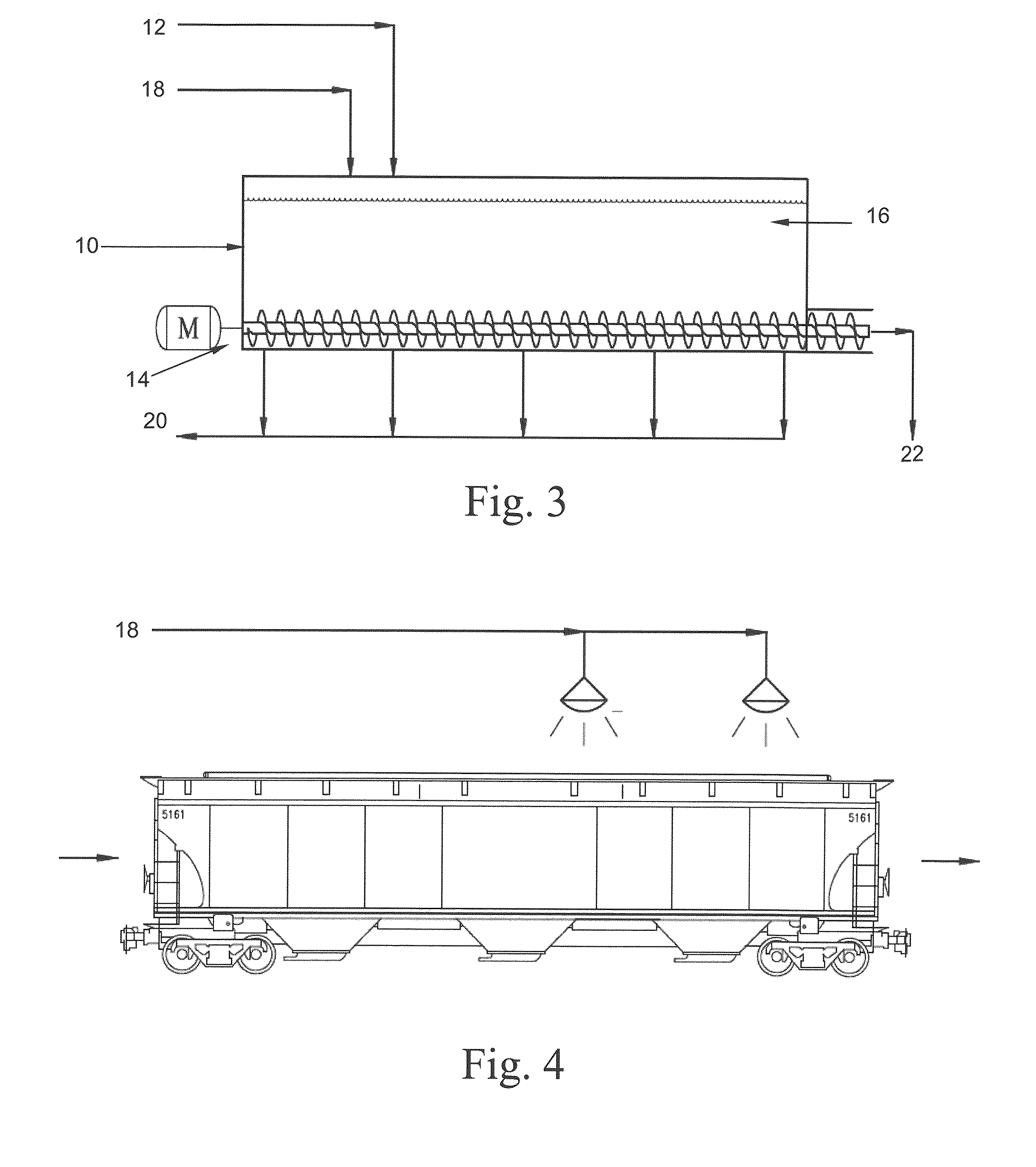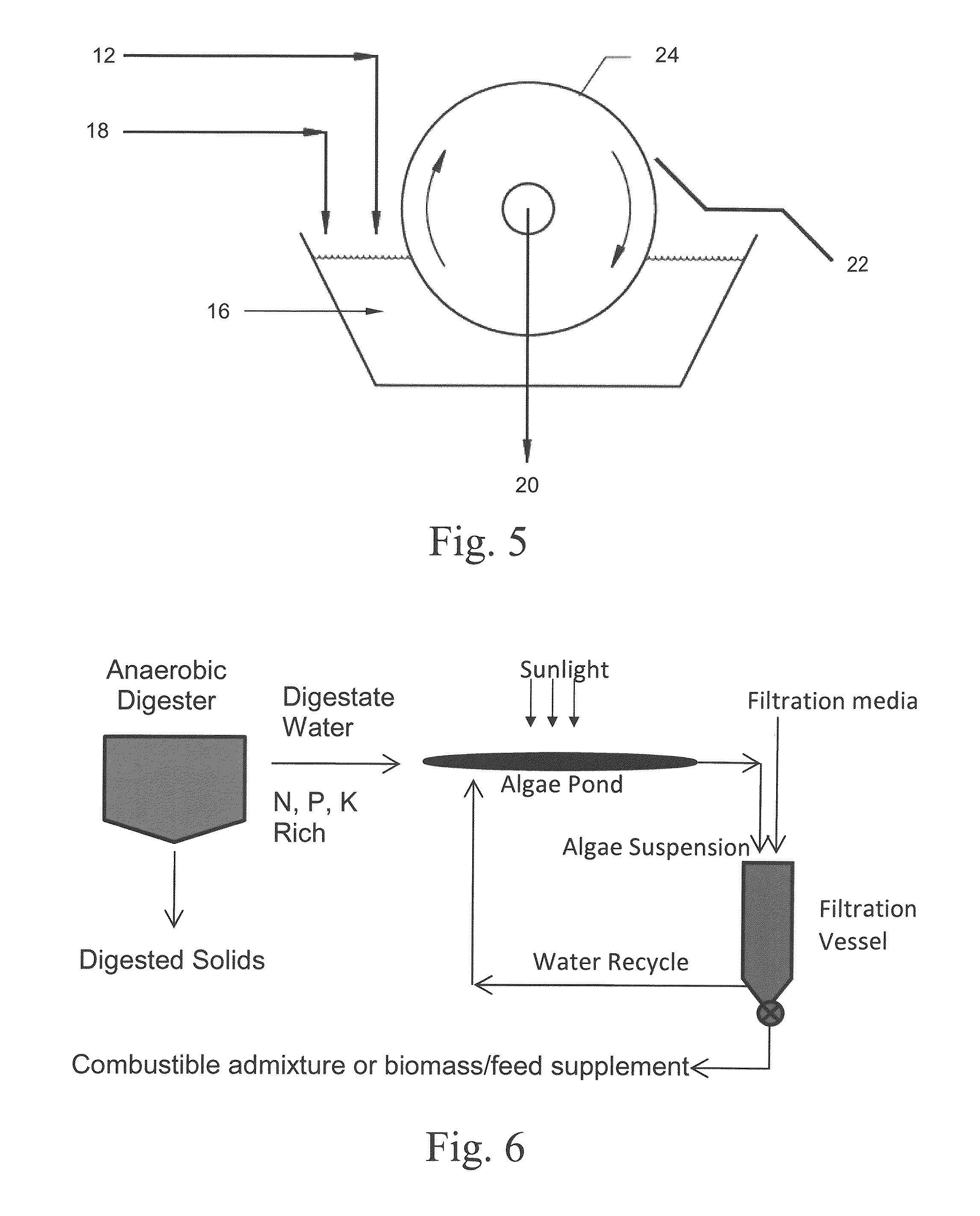[0025]Suitable sources of algae include any environment (e.g.,
liquid medium) suitable for
algae growth. Specific examples include naturally-occurring algae-laden water streams, natural or man-made ponds and lakes (including ponds designed specifically to grow algae), polluted water streams, cattle feed lot ponds, concentrated
animal feed operation (CAFO) ponds, algae culture vessels, algae open ponds, algae closed ponds, algae raceway ponds,
settling basins, water troughs,
water holding tanks,
wastewater,
seawater, photobioreactors, anaerobic digester
effluent, freshwater,
salt water,
brackish water, brine, and combinations thereof. The invention is suitable for filtering any aquatic algae species, blends of species, natural mixtures of species, and / or
genetically engineered species. Some preferred types of algae for use in the invention are selected from the group consisting of Diatoms,
Chlorophyta (
green algae), Euglenophyta, Dinoflagellata, Chrysophyta, Phaeophyta (
brown algae), Rhodophyta (
red algae), and
Cyanobacteria (blue-
green algae). Particularly preferred algae genera within the above groups include Botryococcus, Ankistrodesmus,
Chlorella, Coelastrum,
Scenedesmus, Klebsormidium, Dictyochloropsis, Kirchneriella, Phormidium, Lyngbya, Oocystis,
Oscillatoria, Cosmarium, Leptolyngbya,
Monoraphidium, Phormidium, Ulothrix,
Anabaena, Uronema, Hydrodictyon, Chlorococum,
Cladophora, Lemna, and combinations thereof, with
Botryococcus braunii being a particularly preferred species. The invention is particularly suited for filtration of microalgae (1-10 μm). The invention is suitable for filtration of brines and brackish growth media, as well as freshwater algae suspensions (including municipal /
treated water sources). However, depending on the type of algae, the
salinity of the algae suspension will preferably range from about 0M to about 3M, more preferably from about 0M to about 0.7M, and even more preferably from about 0M to about 0.1M. One
advantage of the present invention is that the methods can be used with native algae sources, and do not require special cultivation procedures or manipulation of the algae source (such as increasing
salinity, or manipulating
lipid content by supplying extra or special nutrients, or modifying growth conditions, etc.). This decreases the overall energy input of the
system and provides a more natural
bioenergy source compared to existing algae harvesting methods which often rely on specially cultured algae sources.
[0026]Suitable filtration media will be any organic or inorganic granular, particulate, porous, or fibrous filtering substance. It will be appreciated that the filtration media can be ground, crushed, or pulverized to achieve the desired particle or
fiber size prior to filtration. In one embodiment, the filtration medium is preferably a combustible material. Examples of suitable combustible filtration media include carbonaceous solids, fibrous
plant materials, torrified
biomass, fibrous
animal waste, fibrous industrial or recyclable waste products, paper products, and combinations thereof. Particularly preferred filtration media in this embodiment are selected from the group consisting of
coal (e.g., fines, raw, crushed, pulverized, screened, wet or dry),
petroleum coke (e.g., fines, raw, crushed, pulverized, screened, wet or dry),
charcoal, torrified and untorrified
biomass (e.g., wood, grasses,
straw, leaves, hulls, shells,
bagasse,
chaff,
corn stover, distillers dried grains,
sawdust, ground refuse,
manure, paper,
paperboard, pulp, seed cleanings,
hay,
ground corn, wheat,
wheat middlings,
soybean hulls,
oat hulls, milo, rye, oats, soybeans, alfalfa,
canola meal, safflower, safflower
meal, corn
gluten feed), hemp, jute, cotton, plastics (e.g., nylon,
polyester), and mixtures thereof. The methods can be used to enhance the
combustion value of the filtration media, and can include subsequent
fermentation processes prior to
combustion. In another embodiment, the filtration medium is a non-combustible,
inert carrier, such as rocks, sand, gravel, minerals,
ceramic,
dirt, clay,
metal,
metal mesh or screens, sintered
metal, pebbles,
fly ash, aluminosilicates, glass, porous glasses,
lime, limestone, ash,
activated alumina, silica, zeolites, and mixtures thereof. In this embodiment, the carrier component of the admixture is not actually combusted or burned, but is instead collected or removed from the
combustion chamber, once the algae is combusted, and recycled for use in subsequent filtration processes. Heat can also be recovered from the carrier via heat exchange before reusing the carrier for filtration. In a further embodiment, the methods can be used to enhance the nutritional value of the filtration media for
animal feed or food supplements. Suitable filtration media in this embodiment includes the grains,
plant materials, and biomass, listed above, as well as
fermentation byproducts (e.g., distillers dried grain),
chaff, flour, and mixtures thereof. Other materials that could be used as filtration media include tires, rubber, fabric, gauze, fiberglass, aggregate, batting,
soot, carbon, shale,
activated carbon, filter membranes, magnets, diatomaceous earth, and Kieselguhr.
[0027]In one embodiment, the filtration media is paper or paper pulp. In this embodiment, the resulting wet admixture can be used as fuel, or dried and used as fuel. In addition, the admixture can be pelletized or briquetted for use as fuel, such as in a
wood burning stove. Alternatively, the admixture can be treated for
recovery of algae oil, or further processed and recycled for re-use as paper.
[0028]In a preferred embodiment, the filtration media is
coal, with the resulting algae / coal admixture being fed into a coal-fired power
plant for combustion (e.g., into a
combustion chamber for burning). The admixture is burned to generate heat, which is converted into
electricity in the power plant. Preferably, the admixture is pulverized into a
fine powder of talcum-consistency prior to combustion, as in conventional pulverized coal power plants. Advantageously, dried algae has roughly the same energy output as coal. Thus, in the algae / coal admixture, the algae displaces some of the coal used in the process, decreasing the total amount of coal necessary for combustion, with roughly the same
total energy output. For example, a 10-lb. sample of the dried algae / coal admixture (containing 1 lb. of algae and 9 lbs. of coal) could be combusted to yield the same energy output as 10 lbs. of dried coal. Accordingly, this process would be eligible for a
carbon credit, and the energy produced by the algae component of the admixture would be
renewable energy and qualify towards
Renewable Energy Portfolio Standards. The
carbon dioxide generated by the power plant could also be used as a
nutrient for the algae source, as described below. Preferred types of coal for use in the invention are selected from the group consisting of
anthracite, lignite, sub-bituminous (e.g.,
Powder River Basin), bituminous (e.g., Appalachia; Ill.), steam, cannel coal, and combinations thereof.
Coal is generally available in sizes of from about 2 inches and smaller down to the fines (which are usually less than 50 microns). Preferably, the raw coal received from the mine,
conveyor belt or rail car performs well in capturing algae “as is,” however, if this is not the case, then the coal is preferably crushed, pulverized, and / or screened prior to use. When used, pulverized coal preferably has an average particle size of from about 3 microns to about 1 mm, more preferably from about 27 microns to about 425 microns, and even more preferably from about 50 microns to about 200 microns. Crushed coal preferably has an average particle size of from about 0.3 mm to about 25 mm, more preferably from about 0.4 mm to about 5 mm, and even more preferably from about 0.5 mm to about 1 mm. In some embodiments, the combination of crushed and pulverized coal is preferred. The term “particle size,” as used herein, refers to the maximum surface-to-surface dimension of the coal particles or pieces. The “average” particle size refers to the size which typifies a given sample of the coal, although it will be appreciated that some particles or pieces in the sample will be slightly smaller or larger than this value. It will also be appreciated that depending upon the size of the filtration vessel, the particle size of some of the coal pieces can be as large as 60 mm or larger in some embodiments, such as a coal rail car.
[0029]Regardless of the embodiment, the filtration method comprises contacting the algae suspension with the filtration media, which generally involves collecting and pumping or otherwise transporting the algae suspension from the source of algae and contacting it with the filtration media. The concentration of the algae in the natural suspension will preferably range from about 0.01% by weight to about 1% by weight, more preferably from about 0.06% by weight to about 0.5% by weight, and even more preferably from about 0.06% by weight to about 0.2% by weight, based upon the total weight of the suspension taken as 100% by weight. If necessary or desired, the algae suspension can be preconcentrated using
flocculation or gravity
sedimentation (e.g.,
centrifugation or passive separation using
settling ponds and vessels) or other methods. Other methods for preconcentration include the use of
dewatering agents, such as flocculants, coagulants,
water soluble polymers, organopolysiloxanes,
sodium hexametaphosphates, alkylphenyolethyloxalate,
electric charge manipulation, and peptiding agents. The concentration of the algae in the preconcentrated suspension will preferably range from about 0.2% by weight to about 10% by weight, more preferably from about 0.5% by weight to about 7% by weight, and even more preferably from about 1% by weight to about 5% by weight, based upon the total weight of the suspension taken as 100% by weight. The algae concentration in the resulting filtrate will be at least about 70% less than in the initial algae concentration of the suspension, preferably at least about 90% less than in the initial algae suspension, and more preferably at least about 98% less than the initial algae concentration of the suspension, and even more preferably about 100% less than the initial algae concentration of the suspension.
[0030]In one aspect, the algae suspension is contacted with the filtration media using a filtration
bed. This aspect relies on a
bed of filtration media through which the algae suspension flows, usually downward, under gravity or active pressure. The alga is collected on the filtration media and in the interstitial spaces or voids between the particles or granules of media throughout the volume of the media. More specifically, a filtration vessel having an inlet and an outlet is partially or completely filled with filtration media to create the filtration
bed. Preferably, at least about 60% of the interior volume of the vessel is filled with the filtration media. In some embodiments, the filtration bed comprises
layers of different filtration media or
layers of the same filtration media of different particle sizes. In general use, the algae suspension is fed into the inlet, passed through the filtration media in the bed, and the resulting filtrate exits the vessel outlet. The filtrate can be recycled back through the vessel multiple times, sent back to the algae source, collected for later use, or simply discarded. A preferred filtration vessel is depicted in FIG. 2. The vessel 10 is a cylindrical column oriented vertically. It will also be appreciated that although a cylindrical column is depicted, any suitable cross-sectional shape could be utilized (e.g., oval, square, geometric). The inlet 12 is at the top of the vessel 10, and the outlet 14 is at the bottom of the vessel 10. The vessel 10 can be configured with the appropriate valves, lockhoppers, nozzles, distributors or removable heads for input and removal of the algae suspension and filtration media. The vessel 10 is filled with the filtration media to form the filtration bed 16. The algae suspension 18 is then added to the vessel. As the suspension 18 flows through the bed 16, the algae is collected by the filtration media and the filtrate 20 exits the outlet. The resulting admixture 22 is removed from the vessel for subsequent
processing. It will be appreciated that the size and dimensions of the vessel will vary greatly, depending upon a given application of the technology (e.g., large-scale commercial / industrial vs. small-scale operations). The length of the vessel will generally range from about 1 ft. to about 100 ft., more preferably from about 10 ft. to about 100 ft., and even more preferably, from about 30 ft. to about 70 ft. The
diameter (or width, as the case may be) of the vessel will preferably range from about 10% of the length to about 50% of the length of the vessel, and more preferably from about 15% of the length to about 25% of the length of the vessel. Regardless of the shape, the interior volume of the vessel preferably ranges from about 8 ft3 to about 8000 ft3, and more preferably from about 100 ft3 to about 6000 ft3. The ratio of the bed depth to
diameter (or width) is preferably from about 10:1 to about 2:1, and more preferably from about 6:1 to about 4:1.
 Login to View More
Login to View More 


